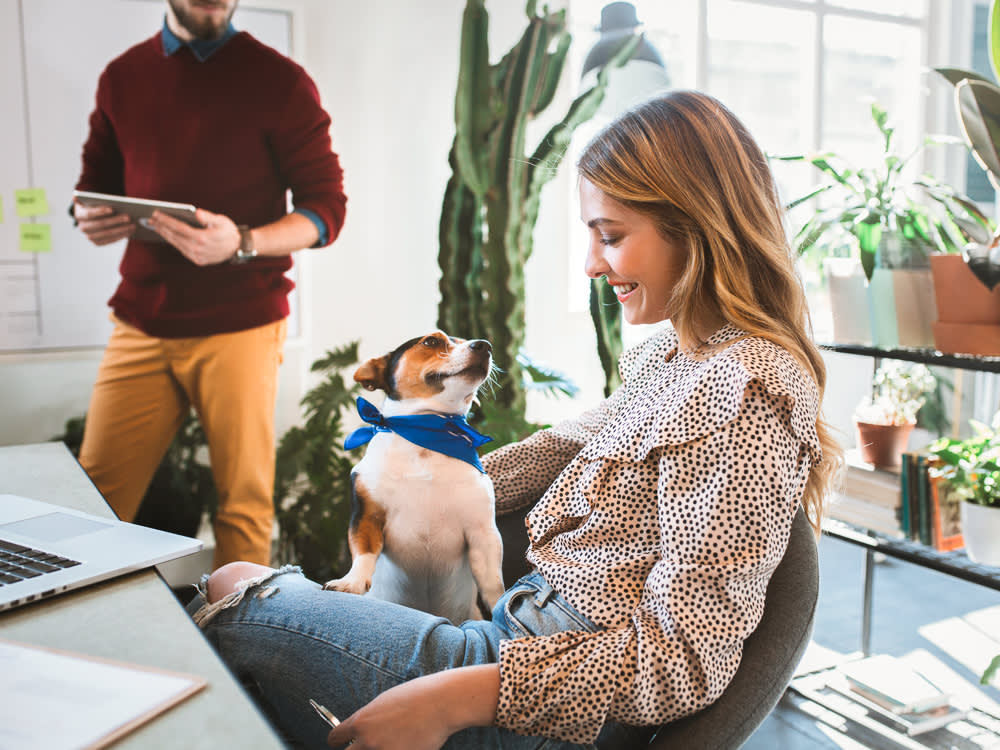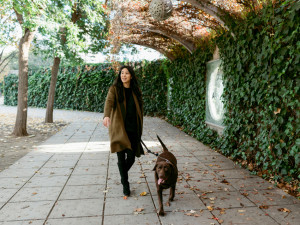8 Reasons to Take Your Dog to Work
June 25th is Take Your Dog to Work Day. From reducing stress to improving morale, here’s why pet-friendly offices are where it’s at.

Share Article
This Friday marks what’s likely the most significant National Take Your Dog to Work Day since the holiday started. Back in 1999, Pet Sitters International declared the day to encourage workplaces to allow dogs and potential pet parents to adopt from shelters. Since then, the number of U.S. workplaces that allow office dogs has risen to eight percent — mostly in the tech world. Uber’s offices are strewn with dog beds, Airbnb employees’ pets have company IDs, and Amazon (a company that’s allowed dogs at HQ for 20 years) has an on-campus dog park and complimentary poop bags.
The trend was, to say the least, disrupted early last year, when companies started banning both dogs and humans from the workplace. In the ensuing year of WFH, as dog adoptions rose, so did an awareness of how well dogs integrate into full and modern work lives. Now, as people consider returning to spaces recently deemed high-risk, a 2017 finding in the International Journal of Environmental Research and Public Healthopens in a new tab seems especially relevant: a sense of being cared for, kind of a dog specialty, serves as “a key factor in whether people with serious mental illness return to work or remain employed.”

littleKin™ is Kinship’s home just for puppy and kitten parents. Bop over to check out expert advice, new pet tools, and special deals—all curated for your newest family member.
opens in a new tabBut office dogs do more than help you remain employed; they help you connect to peers, inspire dialogue, and foster the creativity that helps you thrive. Not all dogs are right for a workspace; namely, those who are too shy and fearful or insufficiently trained to be a chill, non-carpet-soiling member of office culture. The ones who do work at work bring a host of unexpected benefits. An NYC director of production design, Basha Margulies, discovered most of these in her 10 years at a luxury beauty brand where she worked alongside her Miniature Dachshund Sammy. Here, she helps us break down eight jobs that dogs excel at in the workplace.
1. Enhance Communication
“I was still meeting my colleagues when I first brought Sammy in. She went everywhere with me. And I had her for so long that everybody knew both of us and got excited whenever they knew she was coming. In a way, she really helped bring me into a new workplace.”
2. Reduce Stress
“When you look over and you see your dog, you just take a moment to relax. Because, you know, they’re dogs — they’re amazing. They help you and the people around you. A coworker might have been having a bad day, come by, and be like, ‘Okay, I’m just gonna hug your dog for a few minutes.’ And Sammy would force me to take a timeout — take the mental break I might not realize that I needed.”
3. Improve Morale
“The creative department was very laid-back: open floor plan, all sorts of dogs allowed. Sammy was tiny — a Miniature Dachshund — but people would come in with labs and big dogs, maybe just once a week. The regular dogs would come to meetings with us, run around a little, sleep by their owners’ desks. It was part of the culture since I started, and it made the environment such a great place to work.”
4. Foster Communication
“When I was going to start work there and heard that the SVP loves dogs, immediately the job became more appealing. And the first time I ever interacted with the SVP, he got down, face to face, with my dog because he is a dog lover and had dogs. That’s how we first connected — because of my dog.”
5. Reduce Cost
“I had a dog walkeropens in a new tab who was great, but it was nice not to need one. When I started to bring Sammy in, I was able to save money not only in payment for dog walking but also in transit, since I would have been going home more often to walk and care for her.”
6. Improve Productivity
“Sammy definitely relaxed me, and when you’re more relaxed, you do better work. At the very least, you work better when you’re not worrying about something else. She’s so tiny that she could lie in her bed next to my computer, and seeing her sides rising and falling would center me. I’d also stay later to keep working on a project when I knew I didn’t have to run home to care for Sammy, especially as she got older.”
7. Foster Warmth Toward Colleagues
“I think people see a different side of you with your animal there. I think you see a different level of compassion and love that you wouldn’t necessarily see from your coworker. A softness versus when you’re just trying to get your job done.”
8. Remind People What’s Important
“I had Sammy for just over 18 years, so for the 10 years I worked there, everyone greeted us a unit: ‘Hey, it’s Basha and Sammy!’ As she got older and wasn’t doing so well, it gave me such peace of mind to have her with me and I think it made everyone more empathetic. When she died, it was the hardest thing I’d ever gone through. My boss was like, ‘Take time off work.’ People sent me flowers. I was a mess, but I can’t imagine how much harder it would have been if I’d had to hide that at work. You spend more time at work than anywhere, so it was important that people knew who she was. They knew her, they knew her with me.”

Chris Norris
Chris Norris is a writer, reporter, author, and longtime companion to West Highland terrier Gus, recently departed but intensely loved. Chris Norris is has written for The New Yorker, New York Magazine, The New York Times Magazine, Rolling Stone, GQ, Details, and NPR’s “All Things Considered.” He lives in New York City with his wife and 10-year-old son.

